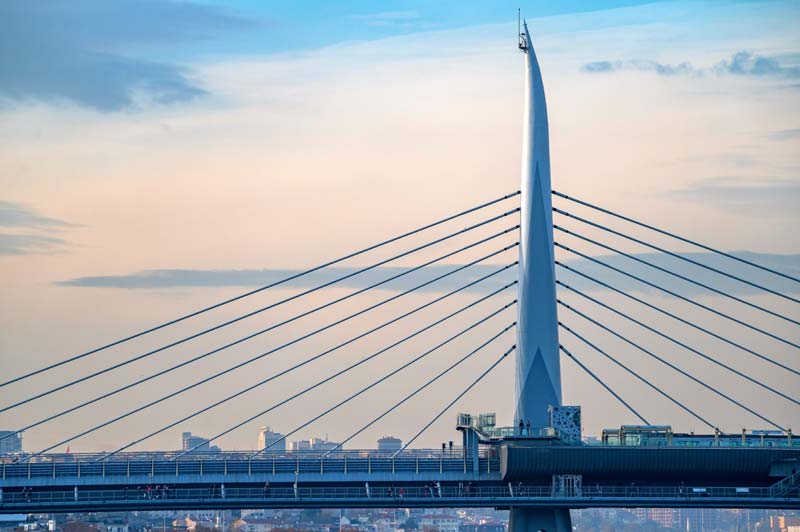Load-Bearing Elements
The main cables of the Messina Strait Bridge play a crucial role as the load-bearing elements of the suspension bridge. Specifically, the bridge includes 2 pairs of high-strength steel cables placed 52 meters apart. Their structural importance is such that they must last 200 years without requiring substantial maintenance, as they constitute the most critical element of the entire infrastructure.The Main Cables of the Messina Strait Bridge
Messina Bridge
The main cables of the Messina Strait Bridge represent the beating heart of the entire structural system, the elements that allow the suspended span to maintain stability and continuity. These cables, of exceptional dimensions, are designed to support the weight of the road and railway deck, uniformly distributing the enormous stresses generated by traffic, vibrations, wind, and earthquakes typical of the area. Their realization is the result of years of advanced studies, experimentation, and comparisons with technologies used in the world’s largest suspension bridges, such as the Akashi Kaikyō Bridge in Japan or the Great Belt Bridge in Denmark.
Each of these cables consists of thousands of high-strength steel wires, gathered into strands and enclosed in robust protective sheaths that defend them from marine corrosion and thermal variations. With a diameter exceeding one meter, they extend for kilometers between the anchor blocks and the supporting towers, supporting via the vertical suspenders the deck on which vehicles and trains travel.
Their elastic behavior is designed to absorb load variations, thermal expansions, and wind-induced oscillations, always ensuring safety and travel comfort. Their design and installation require specialized techniques, such as aerial spinning, which allows each wire to be tensioned individually, grouped, and compacted to form the final cable. Each phase is accompanied by instrumental checks and continuous tension monitoring, to prevent imperfections that could compromise the bridge’s equilibrium.
The main cables, although hidden from the view of those crossing the bridge, constitute the true backbone of the structure: without them, the entire deck could not remain suspended between the two shores of the Strait, nor guarantee the safety and reliability performances required for an infrastructure of this scale.
HIGHLIGHT
Messina Bridge
IN DETAIL
Messina Bridge
Dimensions and Characteristics
Messina Bridge
The project includes two pairs of main cables (four in total), with a diameter of approximately 1.26 meters each. Each cable has a diameter of 1.26 meters and is composed of 349 prefabricated parallel wire strands, which in turn contain 127 wires each, for a total of 44,323 wires per single cable. The length of each cable is approximately 5,300 meters, with a total weight of approximately 170,000 tonnes for the four cables.
Their configuration is designed to minimize elongation under load and guarantee uniform elastic behavior. The external surface is treated with protective coatings that preserve its durability in a marine environment characterized by humidity, salt spray, and strong air currents.

Materials
Messina Bridge
The main cables of the Messina Strait Bridge are made of high-strength steel. This material is chosen because it guarantees an optimal combination of mechanical strength and durability, necessary to support the heavy structural loads and environmental stresses to which the bridge will be subjected.
High-strength steel is particularly suitable for cables because it can withstand high tensions without deforming, maintaining the bridge’s stability even under extreme conditions such as strong winds, earthquakes, and the aggressive marine environment. Furthermore, the steel is protected against marine corrosion to ensure a lifespan of at least 200 years without the need for significant maintenance.

Structural Function
Messina Bridge
The main cables have the function of supporting the suspended deck via a dense network of vertical suspenders (or suspension cables). The weight of the roadway, railway tracks, and vehicles in transit is transferred to the cables, which in turn discharge the forces onto the towers and anchorages. This scheme allows for homogeneous load distribution, keeping the span stable even in the presence of intense traffic or wind gusts.
The controlled elasticity of the cables allows them to absorb oscillations and thermal expansions, avoiding stress concentrations that could compromise the structure’s safety.

Construction and Installation Technologies
Messina Bridge
The construction of the main cables takes place using the aerial spinning technique, already employed in the world’s major suspension bridges. The steel wires are tensioned individually between the anchorages, then grouped and compacted to form the final cable. Once assembly is complete, tightening systems and protective sheaths are applied, followed by load tests to verify the correct tension.
The process requires millimeter precision: even small differences in the length or tension of the strands can influence the global behavior of the bridge. For this reason, sensors and real-time control software are used, capable of monitoring every phase of the installation.

Maintenance and Monitoring
Messina Bridge
The main cables will be constantly monitored through a Structural Health Monitoring (SHM) system. Sensors installed along their path will measure vibrations, deformations, and temperature, allowing for the prevention of any critical issues. Periodic visual inspections and tension tests will be performed to ensure that performance remains within the design parameters.

Symbolic Value
Messina Bridge
In addition to their technical function, the main cables represent a symbol of connection and balance. Invisible to those crossing the bridge but decisive for its stability, they embody the “invisible but strong” link that unites Calabria and Sicily, transforming an engineering masterpiece into a work of cultural and landscape value.

Data Related to the Main Cables of the Messina Bridge
Messina Bridge
| Parameter | Value / Description |
|---|---|
| Number | 4 main cables (2 pairs) |
| Nominal Diameter | ≈ 1.26 m per cable |
| Composition | Thousands of high-strength, galvanized steel wires; organized into compacted strands |
| Indicative Length | Over 3 km per cable (from anchorage to anchorage, passing over the towers) |
| Structural Function | Support of the deck via network of suspenders; load transfer to towers and anchorages |
| Installation Technique | Aerial spinning: tensioning of individual wires, grouping, compaction, and final tightening |
| Protection and Durability | Protective sheath, anti-corrosion paints and tapes; drainage systems and joint sealing |
| Dynamic Performance | Controlled elasticity for thermal expansions and wind; vibration damping with dedicated devices |
| Monitoring | SHM system (tension, deformation, temperature sensors; periodic inspections) |
| Interfaces | Saddles at tower top; anchorage blocks with high-strength plates and bolting |
| Regulations/Validations | Wind tunnel tests and FEM models; performance criteria for marine environment and seismic area |
| Note: The reported values are indicative and subject to refinement during the executive design phase. | |





